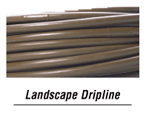I mentioned in the previous post (Watering with a Firehose: Drip Emitters) that there are two types of application when it comes to drip. Poly tubing with built in emitters is the second type of drip and perhaps more commonly used for Outdoor Living Spaces and flower beds than the emitters. 
Landscape dripline is little more than a glorified soaker hose and instead of distributing water to individual plants, relies more upon the flood irrigation method of watering. Dripline is poly tubing with evenly spaced emitters that release water slowly. The water spreads out a short distance from the tubing, but basically waters only right next to the tubing. There is an excellent application for dripline, and I will discuss this application in the next post.
Even though dripline uses less water than broadcast watering (sprays), it still does not conserve water like emitters do, largely because it waters bare soil. Dripline would therefore rank somewhere between emitters and sprays in efficiency when used for large flower, shrub and tree plantings.
Despite the lack of efficiency, dripline is still looked upon as a social statement, boldly declaring one’s green-ness to the world. I applaud sustainable landscapes for the money-saving strategies and responsible stewardship of our water resources, but perhaps dripline should not be lauded as the answer to saving and being responsible–at least when it comes to large perennial, shrub or tree plantings.
As I mentioned earlier, dripline works great for flood irrigation. This is best achieved by creating a grid with a supply line running around the perimeter of the area and dripline evenly spaced in parallel lines, crossing the area.
I commend you if you have installed dripline in your yard! You have taken great steps toward saving money and being responsible. Also, it is very simple to adjust dripline to a more efficient method.